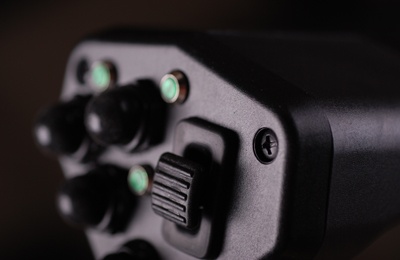The simple definition of Hall effect is: reading magnetic force to create a proportional output, or proportional signal to create a specific output. In our industry, Hall effect technology is the latest and greatest state-of-the-art application used for human-machine interface-- joysticks, pedals, and more.
 The technology itself is actually fairly old, having been discovered by renowned physicist Edwin Hall in 1879. But the electronic circuitry really didn’t start to become compact, efficient, and economical enough to implement into products like ours until about 2001. As the circuitry, magnets, and chips continue to evolve and get smaller, and as our engineering and design capabilities expand through our work making custom-designed mechanisms, the overall usage of Hall effect in that technology will only take off.
The technology itself is actually fairly old, having been discovered by renowned physicist Edwin Hall in 1879. But the electronic circuitry really didn’t start to become compact, efficient, and economical enough to implement into products like ours until about 2001. As the circuitry, magnets, and chips continue to evolve and get smaller, and as our engineering and design capabilities expand through our work making custom-designed mechanisms, the overall usage of Hall effect in that technology will only take off.
WEAR LESS, KEEP GOING
Through recent years, the standard for controller technology has been the potentiometer, either wire-wound or element-type. A hard mechanical device. The problem with the potentiometer is that over time, with a wiper constantly going against wound wire or some sort of carbon element, it’s going to become damaged and eventually wear out.
In contrast, Hall effect is a “wear-less technology.” While even the joysticks we manufacture will see mechanical wear after 10 million repeated operations, Hall effect electronics do not see the same degradation. You don’t have to “fix” an electronic joystick if it fails; you simply unplug it and put another one back in. Yet the Hall effect technology itself is not the thing that’s going to fail. That’s why we’ve committed our electronic assembly to incorporate Hall effect sensors into our products going forward, on the boards we make in-house on our two – surface mount circuit technology machines, because that is a core capability that we provide.
DO MORE, SPEND LESS
With Hall effect technology you can get more out of your electronics, using the same footprint. We are able to incorporate more inputs and output capability on the electronic board to take from the joystick. So if your hand could handle ten or fifteen buttons or contacts, they can go onto the electronic board. Our custom design process allows for getting electronics and utilization out of the handle and off the panel system, and on the joystick CAN-bus.
Even though an electronic joystick may cost a little bit more up-front because it has so much more I/O capability, the all-incorporated design actually saves money over the long-term, as well as saving time for wiring, setups, manufacturing and assembly. It also provides more benefits to the customer through the value-added configurations and options we can provide. With Hall effect technology, we can put five push buttons, a proportional roller, a proportional twist, and another proportional mini-joystick right there in the handle. There’s no way you could have done that with a potentiometer; it just wouldn’t fit mechanically or ergonomically.
Hall effect electronics in our on-board circuitry enables us to get more functionality into the overall joystick than was ever imaginable before. Designing the most capability into the joystick and in a very centralized location puts functionality in the palm of the user’s hand, increases productivity for the end customer, and saves the organization money in assembly, overall cost and reduce returns for electronic repairs.
Do you have a Hall Effect story you'd like to share with us? Great! You can tell your story in the comments area below.
.png?width=225&height=65&name=oem-corporate-logo(1).png)

